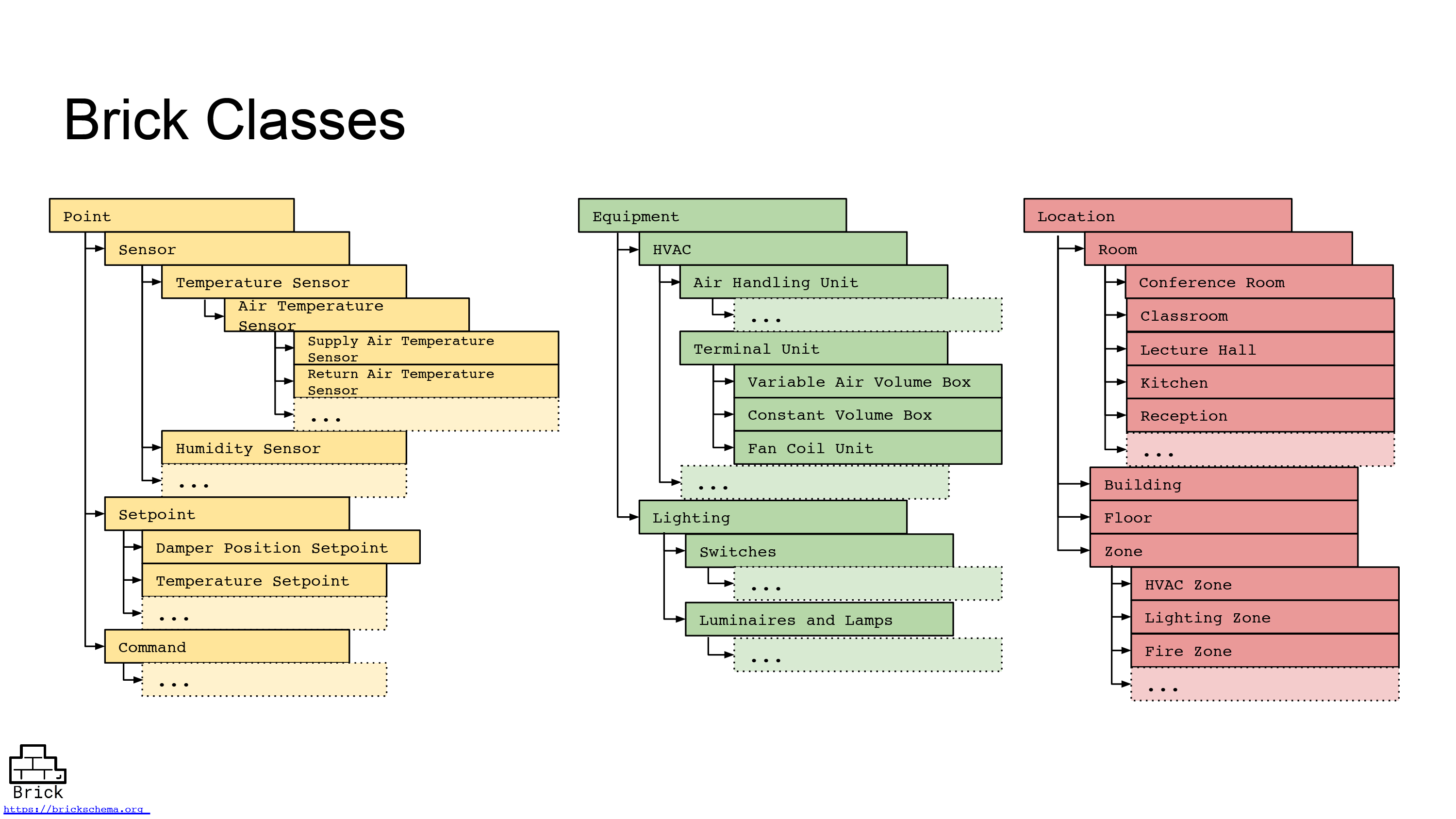As commercial buildings continue to evolve in the global pandemic era, learning more about Brick Schema, and how it leverages metadata to influence healthy buildings, is critical for both consulting and mechanical engineers.
According to BrickSchema.org, Brick is an open-source effort to standardize metadata about buildings and the relationships between building assets. Using this metadata and information generated from sensors around the building, Brick is integral for delivering on healthy building concepts, including digital twins, personalized environments, touchless operations, automation, improved efficiency, and predictive maintenance.
The success of these concepts, however, is based on the thoroughness of Brick-based metadata and its coverage of as many systems as possible. Despite being from dissimilar sources, the data generated by devices labeled by Brick Schema can be collected and integrated into a single digital platform, a top-level need for the development of a healthy building ecosystem. Managing metadata and the data produced by system components gives building operators and owners the picture they need to operate next-generation structures. Just as important, it gives engineers the framework they need to help building owners and operators succeed.
A Closer Look at Brick Schema
Not sure what Brick Schema is, or what it does for a building? Let’s break the three primary concepts down:
- Schema – In its purest concept, a schema is an organization of information as a “blueprint” that shows connections between elements. As a computer programming concept, a schema is a logic system or language that shows relationships between components. Schemas are sometimes called ontologies.
- Metadata – Think of metadata as a single card in a library’s card catalog. Like a library card, the metadata used in Brick describes the key information about a building asset. This allows building assets with specific metadata labels to be analyzed or accessed by a centralized system. Metadata is organized according to the rules of the chosen schema.
- Brick Schema – The primary focus of Brick Schema is on building systems, and it is designed to be a catalog of accepted metadata terms, which identify building components, the functions of those components, their relationship to other components, and the type of data they produce. Therefore, Brick is a collection of metadata from a building’s components and allows engineers to see the relationships between them. Since Brick is an industry agreed-upon schema that follows specific rules and styles, components can be added or removed from the digital system and relationships between components can be updated as needed. Additionally, other Brick users and compatible systems will be able to understand this metadata. Finally, Brick Schema is an open-source project, so it’s not proprietary to one manufacturer and available for use by anyone, including building operators.
 Figure 1. The Brick Schema organizes the “what” of a building into a class hierarchy, where each level is a more specific version of its parent. A kitchen is a specific type of room, and all kitchens are rooms, but not all rooms are kitchens.
Figure 1. The Brick Schema organizes the “what” of a building into a class hierarchy, where each level is a more specific version of its parent. A kitchen is a specific type of room, and all kitchens are rooms, but not all rooms are kitchens.
Why Is a Common Language Needed?
By using a common language, different OEMs can manufacture building components and systems that can talk to one another during normal operations, including system setup. Additionally, since the data from all these systems and components are organized in a unified way, analytic functionality can be achieved. Taken together, these capabilities allow for the development of technologies and systems that monitor and control a whole building while maximizing efficiency decisions. The use of Brick in a building system should also be a must-have feature for any future purchases so that it can be properly integrated into your smart building.
The Value of Data
The assets labeled with Brick metadata aren’t stagnant — as they go about their normal actions, they (or sensors that monitor those assets) produce data about that operation. Using Brick Schema to sort, organize, and filter the operational data, building owners and operators can gain a deeper knowledge and insights about the relationships and status of all building components. With help from engineers, this sensor-created data, along with the Brick metadata, allows owners and operators to:
- Create and use a building’s digital twin – A digital twin is a virtual representation of a building and its assets that can be used to gauge a building’s present state and its past benchmarks. Using artificial intelligence (AI), it can offer predictions of what is needed for the building in the future. A digital twin is created by combining both the metadata, ongoing sensor data, and other information into a digital representation that allows for deep analysis. Many digital twins are also developed into an adjustable 3D visualization of the facility, which has a variety of uses.
- Analyze occupants as well as assets – As mentioned, the metadata used in Brick Schema allows information about the system to be grouped and sorted, which creates opportunities for analysis of efficiencies, operations, and functionalities. Using fobs, badges, or other individualized IDs that serve as a Brick asset, the actions and locations of occupants can also be gathered, analyzed, and acted upon. This allows the building operator to offer occupant-friendly services in real time, such as automatically opening doors or helping coworkers locate one another.
- Recognize use patterns – The data generated by Brick-enabled building systems and occupants can show how parts of the building are being used, which allows for predictive planning of the building’s maintenance, cleaning, and general operations, including the use of energy intensive assets like the HVAC system.
- See the big picture – With a detailed metadata map, an ongoing collection of data from building assets, and the ability to communicate with those assets, control and analysis of the building as a whole can be centralized through an operations suite, such as Johnson Controls’ OpenBlue. This is the ultimate promise of Brick – that data coming from assets with Brick allows operators to see the big picture of their buildings and act upon it in a unified, highly efficient manner to build occupant satisfaction, achieve sustainability goals, and improve budget performance.
 Figure 2. A Brick model defines the collection of items from specific instances of a building, using the rules of the Brick Schema/ontology. Here, the light blue boxes represent the actual items of a building: VAV2-3 and VAV2-4 are some of the VAVs of an actual building. The Brick Schema assigns metadata to those items: VAV2-3 is of class “Variable Air Volume Box”, and VAV2-3 “feeds” air to the “VAV2-3zone”. The Brick Schema defines the classes and relationships a person can use to model a specific, real-world building.
Figure 2. A Brick model defines the collection of items from specific instances of a building, using the rules of the Brick Schema/ontology. Here, the light blue boxes represent the actual items of a building: VAV2-3 and VAV2-4 are some of the VAVs of an actual building. The Brick Schema assigns metadata to those items: VAV2-3 is of class “Variable Air Volume Box”, and VAV2-3 “feeds” air to the “VAV2-3zone”. The Brick Schema defines the classes and relationships a person can use to model a specific, real-world building.
How Brick Works: Example Scenarios
Brick offers many opportunities to utilize the concept of building components communicating with one another, which happens by exchanging and analyzing quality data through a central hub. Here are a few examples of how Brick can be utilized in a next-generation healthy building or smart campus.
- Real-time status – A building operator can filter metadata to search out specific functions and then access readings building-wide to determine what devices are currently drawing electricity.
- Smart navigator – If a person is going to an event across campus, technology could be used to guide that person (actually, their Brick-labeled fob) from their present location to the event location.
- Fault detection – By gauging room sensors and HVAC on/off readings, Brick can help AI pinpoint faults in a system. For example, an operator could be alerted about a stuck damper since the HVAC system shows it is running at its normal rate, but a room sensor isn’t recognizing an appropriate temperature change.
- Predictive maintenance – A system is regularly measured to create a baseline reading of its standard operation. Later, when the system’s ongoing reading begins to deviate from the baseline, a maintenance task is created to address the change far before it would be noticed by a human technician.
- Space assignments – As people enter the building through a normal swipe-in door, they are also assigned hot desks, which are properly spaced to maintain social distancing. Eventually, a full-occupancy notification is issued to limit additional check-ins and avoid overcrowding within the facility.
The Future of Brick
What will Brick do for buildings in the future? For certain, it will only get more thorough in the amount of metadata it creates for use by a building’s operations hub. Additionally, more and more assets will be coded with metadata. Likewise, manufacturers will be charged with adding more functionalities with which to model in Brick. For building engineers and owners/operators, that additional metadata is the foundation for the constant improvement of the occupant experience and overall operation of a healthy building. Looking more closely:
- Brick for Engineers – Improved elements that engineers will appreciate include plug-and-play systems and the capability to catalog even more data points from each component. For one thing, a plug-and-play approach will make it even easier to build and expand digital twins and building models. Further, this continuous boost in metadata and information will allow more functionality to be achieved from the use of Brick Schema.
- Brick for Owners/Operators – Brick will continue to contribute to the overall occupant experience, which is critical to demand premium occupancy rates. To achieve this, owners and operators must continually invest in data collection opportunities via Brick-friendly digital systems. The more data a building delivers, the greater that information can be leveraged to improve operations and find efficiencies.
- Brick for Manufacturers – Developing more equipment and systems that use Brick is the next step for manufacturers. Doing so means that engineers and analysts have more to work with as they plan building systems. As a result, sensor data will be more expressive, which improves the manufacturer’s understanding of current equipment, giving them actionable data to improve the next generation.
The future certainly looks bright for using Brick, but what should building engineers do today to bring Brick to their operations? The best advice is to simply start planning for its implementation now. Most importantly, building operators and engineers need to work on cleaning up data and creating a consistent reporting structure. Having good metadata now will vastly benefit future translation needs.
Whether you are using Brick Schema now or are planning to use it for a future project, it’s important to both recognize and evangelize its ability to improve the operational capability of a building (or group of buildings). To gain that improvement, an investment must be made in this standardized dataset with a goal of deep integration into as many systems as possible. The greater the Brick integration, the more its metadata can be leveraged to boost efficiency, save on costs, and enhance occupant comfort





